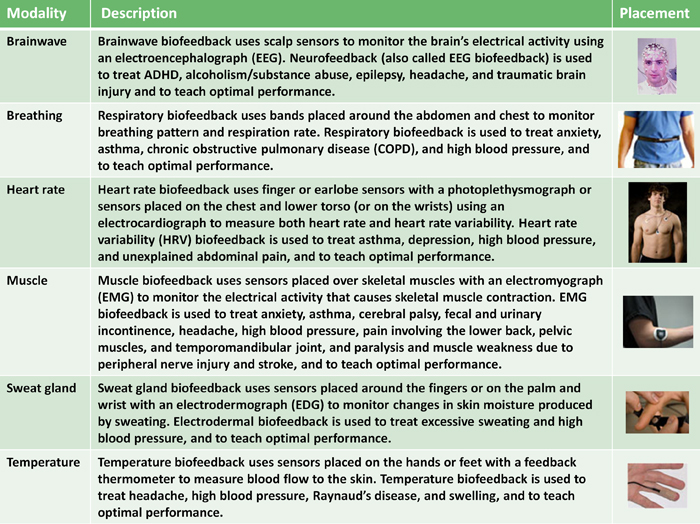The Brain, with its integrated neural network throughout the entire body, carries neural messages to every corner of the body. This is why we are able to learn to notice what we feel, think and do and the effect it has on our entire body. These messages get carried via neurotransmitters, neuromodulators and neurohormones and every cell, muscle or organ in the body can be influenced by the brain.
Biofeedback is a technique to learn how to control internal functions normally outside of our conscious control. You learn this by receiving feedback from sensitive instruments that measure and display your physical or mental processes - making you aware of internal changes that you can’t easily feel or detect on your own. The challenge is learning about the ability to bring change to this internal milieu and how this empowers us to change patterns of thinking and behavior.
Sensors used in a session to effectively give real-time feedback might be a combination of either:
Do you break out in a sweat when you hear a dog bark or does your heart rate increase when you think about going to the dentist???
These are examples of stress reactions that might occur in your autonomic system. These reactions are controlled via your thought patterns which in turn are reflected via the brain and the body. Using the feedback from the sensors (mentioned above) you can see these reactions on a measurable level. The therapist can use these as a guideline in goal setting in monitoring progress with training. Relaxation levels are not just subjective anymore but are objectively measurable.
If it can be measured - it can become a tool that can be used to your advantage
Biofeedback simply means "feeding" information "back" to the individual who generated the bio-signals in their bodies in the first place. External stimuli, such as auditory and visual rewards, can influence physiological changes in the body. From this, we then learn about ourselves and we can utilize this to our advantage.
These feedback tools assist the therapist to guide and help the client to manage or overcome symptoms that are negatively influencing their daily functioning. The following conditions disorders can benefit from this intervention in a therapeutic program:
In order to improve the efficiency of the learning process, the trainee may be subjected to stress profiling to identify the best physiological variable for feedback
Behaviourally, self-regulation is the ability to act in your long-term best interest, consistent with your deepest values. Emotionally, self-regulation is the ability to calm yourself when you're upset and cheer yourself up when you feel down. Learning Mindfulness based Strategies to grow in this self-awareness. Self-regulation is not a trait that some people have and others do not. Rather, “it involves the selective use of specific processes that must be personally adapted to each learning task.”
Candidates for these are students, athletes and anyone that wishes to optimise their performance in school, work, sport or even interpersonal relationships.
